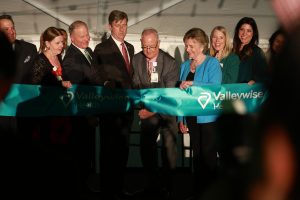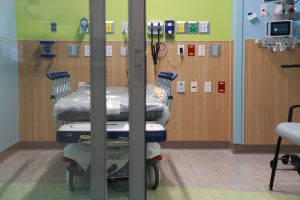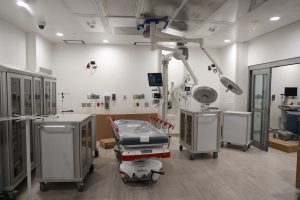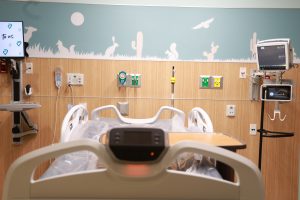- Slug: BC-CNS-New Valleywise Health Center. 850 words.
- Photos available (thumbnails, captions below).
By Brenna Gauchat
Cronkite News
PHOENIX – Valleywise Health refers to its health care system as a safety net for the community and prides itself on serving the Valley’s underserved.
On April 3, Valleywise Health hosted an opening ceremony for its new medical center on E. Roosevelt Street in Phoenix. This center replaces the previous building, which served the public for 53 years.
Standing 10 floors high and sprawling over 673,000 square feet, the new Valleywise medical center features upgraded facilities to provide specialized care to the community. The original hospital in that location was known as the Maricopa County Integrated Health System, renamed Valleywise in 2018.
Proposition 480
Funding for the new medical center was provided by a $935 million bond authorized by Proposition 480, which was approved in 2014 by Maricopa County voters. The bond allocated funds for renovations at existing Valleywise locations in and around Phoenix, as well as construction of a new main facility.
When the proposition was on the Arizona ballot in 2014, then-Phoenix Mayor Greg Stanton openly supported the bond.
“They do incredible work for the community, so when they asked me to support their bond election back in 2014, of course I said yes,” said Stanton, now a Democratic congressman from Arizona’s 4th District.
“Right after the recession, arguably during the tail end of the recession, when they’re (Valleywise) asking for a pretty big dollar amount, almost a billion dollars, I know there was a lot of skepticism in the community,” Stanton said.
Some of the opposition to the $935 million bond for Valleywise came from Kevin McCarthy, president of the Arizona Research Association, who said it was an unnecessary burden on county taxpayers that would fund duplicate health care systems. Hospital executives at other large health care providers also opposed the measure.
“Why should the public go and pay for the cost of replacing that facility when in the general market there’s clearly more than enough capacity to absorb what’s going on,” Banner Health CEO Peter Fine told the Arizona Republic in 2014. “To us, it’s an open checkbook without accountability.”
That year, however, voters said “yes” to Proposition 480 and Valleywise Health was on the path to building its new medical center.
Serving the underserved
The Arizona Health Care Cost Containment System (AHCCCS), Arizona’s Medicaid program, pays for many health services for those who qualify based on income.
“Over 2 million Arizonans are on AHCCCS. That number is going to increase and they’re going to continue to need our support,” Stanton said.
According to the American Hospital Association, Valleywise provides care to a disproportionate number of low income and uninsured people in Maricopa County and more than half of its patients rely on Medicaid.
“We serve a great population of patients who pay out-of-pocket for their services and they do that on a sliding financial scale, so based on what their finances are,” said Lia Christiansen, chief administrative officer of Valleywise Health. “A significant number of our patients are AHCCCS patients … then, of course, we do take commercial insurance and Medicaid as well.”
Valleywise also has a health clinic on campus for women refugees, catering to populations from various countries who are new to the United States..
“For example, several years ago, a large number of folks came from Afghanistan and needed to be settled in the United States. So those folks came through federal programs to various states and cities and Arizona and Phoenix were a large recipient of refugees,” Christiansen said. “That’s how that patient population ends up both in Arizona and with Valleywise.”
Christiansen said Valleywise employs cultural health navigators, interpreter services and support groups to help refugees adjust to life in the U.S.
“We want to be a welcoming community for refugees from around the globe,” Stanton said. “Part of being a welcoming community is not just housing and access to jobs, but also access to culturally competent health care.”
New building, same culture
The new center has fewer beds than its predecessor but features single-patient rooms.
“In the current hospital, we still have rooms that are shared between two and three people,” Christiansen said. “In the new hospital, everybody has their own room and every room has its own window.”
Valleywise Health’s new medical center will be a public teaching hospital with a Level 1 trauma center to treat both adults and children, and home to the nationally recognized Arizona Burn Center, which will be nearly triple the size of the previous burn center.
“Whenever you can coordinate care for patients so that you can reduce the number of clinic visits or hospital visits, that is absolutely a benefit to them,” Christiansen said. “From an insurance reimbursement standpoint or an out-of-pocket standpoint or even just time savings.”
The old building, which stands adjacent to the new facility, will eventually be demolished once patients and staff finish moving over. Laura Stallings, a dialysis manager at Valleywise Health, said while her environment may change, her staff’s commitment to patients will remain the same.
“The heart and soul of the hospital is the staff,” Stallings said. “It’s the same staff, so we’re moving our culture to a new facility.”










